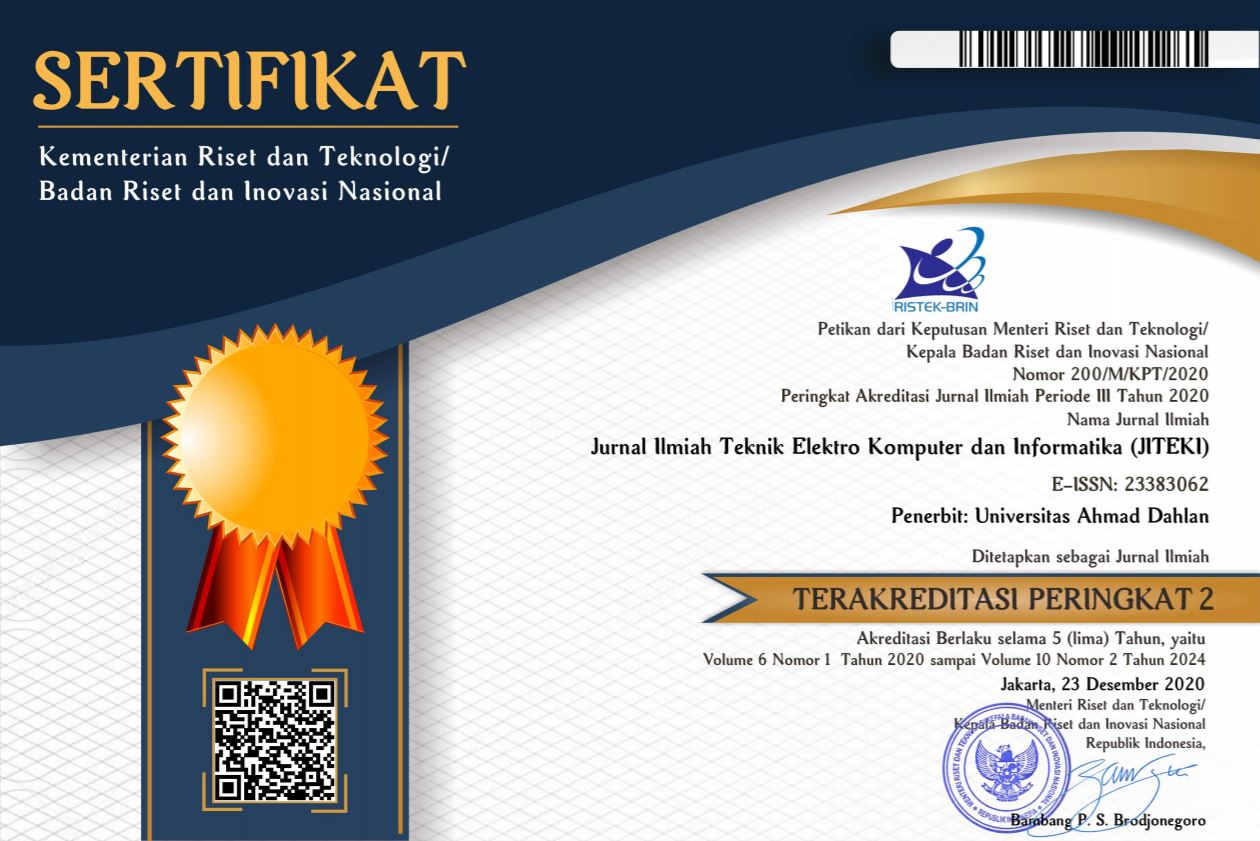Mobile Forensics for Cyberbullying Detection using Term Frequency - Inverse Document Frequency (TF-IDF)
Abstract
Keywords
Full Text:
PDFReferences
Riadi, I., Fadlil, A., & Fauzan, A. (2018b). Evidence Gathering and Identification of LINE Messenger on Android Device. International Journal of Computer Science and Information Security (IJCSIS), 16(June), 201–205.
F. B. Walean, Interviewee, [Interview]. 6 10 2015.
Riadi, I., Fadlil, A., & Fauzan, A. (2018a). A Study of Mobile Forensic Tools Evaluation on Android-Based LINE Messenger. International Journal of Advanced Computer Science and Applications, 9(10), 201–206. https://doi.org/10.14569/ijacsa.2018.091024
RSA, "2016: Current State of Cybercrime," 2013. [Online]. Available: https://www.rsa.com/content/dam/rsa/PDF/2016/05/2016-current-stateof-cybercrime.pdf. [Accessed 5 November 2016]
Umar, R., Riadi, I., & Muthohirin, B. F. (2019). Live forensics of tools on android devices for email forensics. 17(4), 1803–1809. https://doi.org/10.12928/TELKOMNIKA.v17i4.11748
Riadi, I., Sunardi, S., & Kadim, A. A. (2019). Monitoring Log Aplikasi Mobile Native Menggunakan Framework Grr Rapid Response. Jurnal Buana Informatika, 10(1), 1. https://doi.org/10.24002/jbi.v10i1.1909
Zamroni, G. M., & Riadi, I. (2019). Instant Messaging Forensic Tools Comparison on Android Operating System. 4(2), 137–148.
Christof Baron. (2019). Most popular global mobile messenger apps as of July 2019, based on number of monthly active users (in millions). Retrieved from https://www.statista.com/statistics/258749/most-popular-global-mobile-messenger-apps/
Feldman, R., & Sanger, J. 2007. The Text Mining HandBook. New York: Cambridge University Press.
Triawati, C. 2009. Metode Pembobotan Statistical Concept Based untuk Klastering dan Kategorisasi Dokumen Berbahasa Indonesia. Universitas Telkom.
Weiss, S. M., Indurkhya, N., Zhang, T., & Damerau, F. J. 2005. Text Mining: Predictive Methods fo Analyzing UnstructeredInformation. New York: Springer.
Dragut, E., Fang, F., Sistla, P., Yu, C., & Meng, W. 2009. Stop Word and Related Problems in Web Interface. Chicago: Computer Science Department University of Illinois.
Tala, F. Z. 2003. A Study Of Stemming Effects On Information Retrieval in Bahasa Indonesia. The Netherlands: Universiteitvan Amsterdam.
F. A. Hermawati and D. A. Zuhdi, “Aplikasi Sistem Temu Kembali Dokumen dengan Metode Vector Space Model,†KONVERGENSI, vol. 5, no. 2, pp. 38–49, 2009.
Santosh Kumar Sahu, Sauravranjan Sarangi and Sanjaya Kumar Jena, "A Detail Analysis on Intrusion Detection Datasets," in International Advance Computing Conference (IACC), 2014
DOI: http://dx.doi.org/10.26555/jiteki.v5i2.14510
Refbacks
- There are currently no refbacks.
Copyright (c) 2020 Universitas Ahmad Dahlan

This work is licensed under a Creative Commons Attribution-ShareAlike 4.0 International License.
| About the Journal | Journal Policies | Author | Information |
Organized by Electrical Engineering Department - Universitas Ahmad Dahlan
Published by Universitas Ahmad Dahlan
Website: http://journal.uad.ac.id/index.php/jiteki
Email 1: jiteki@ee.uad.ac.id



